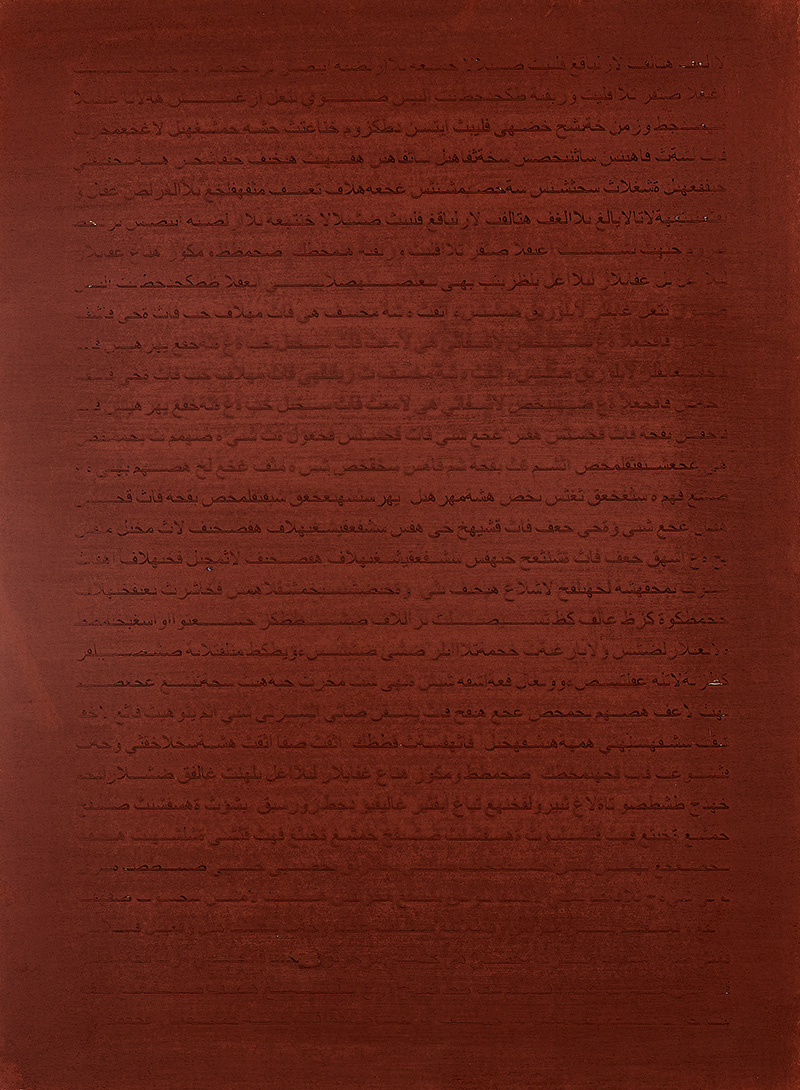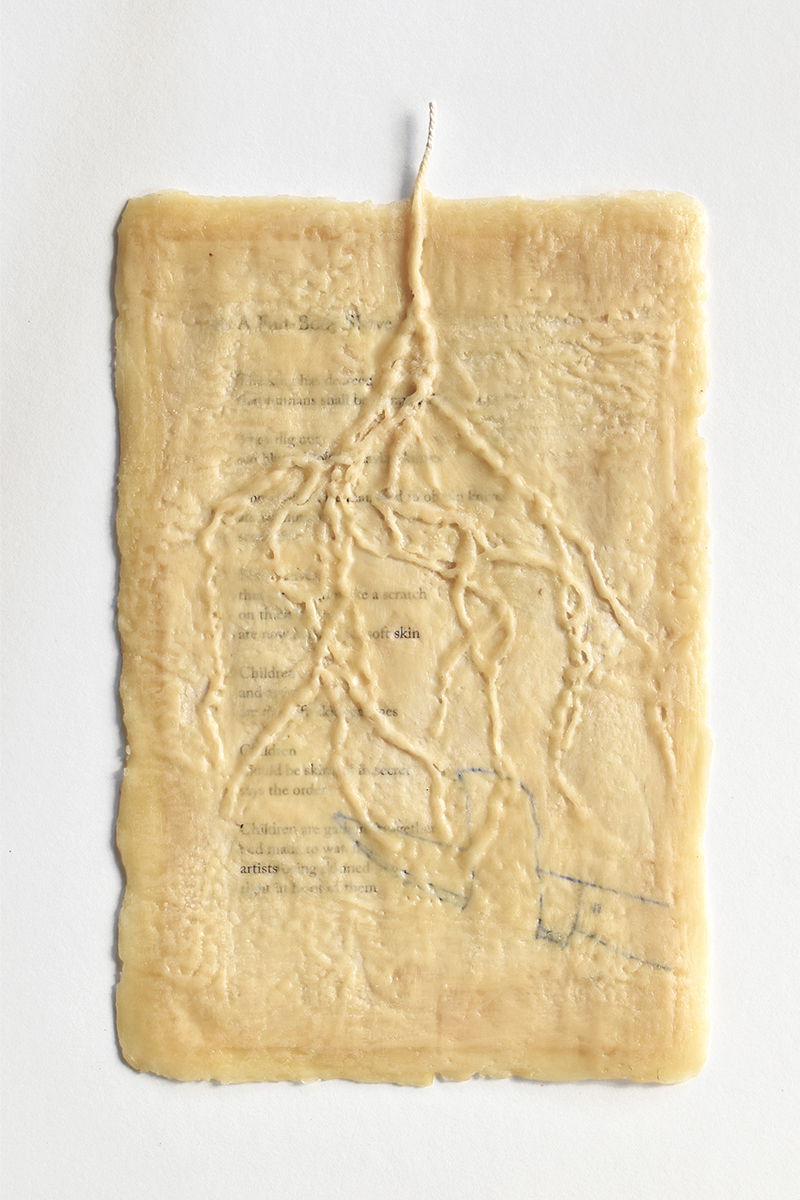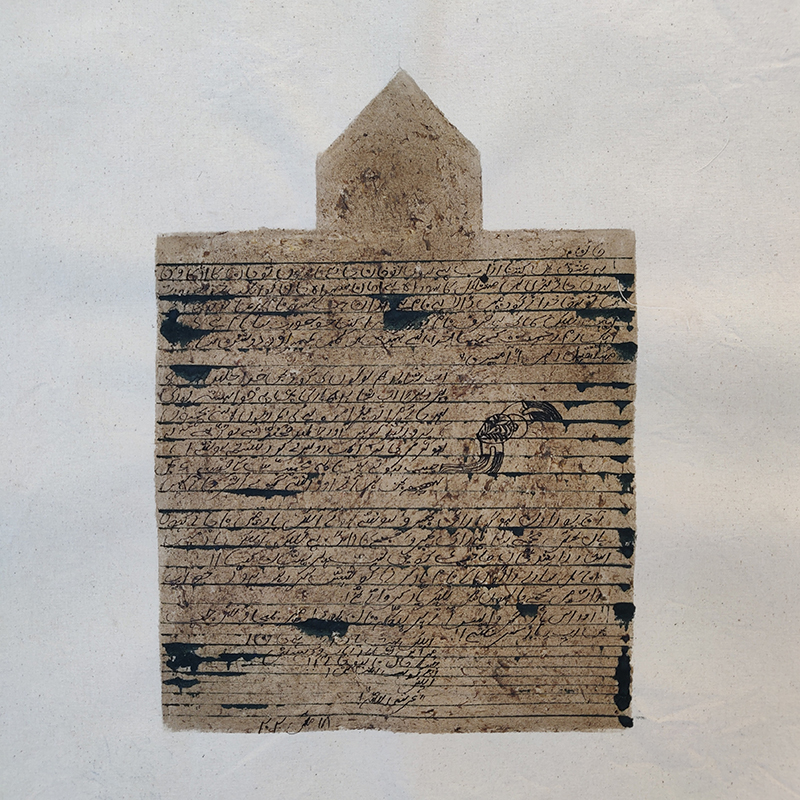I am a person with limited means. I often think I should just sell my art collection and live with less of a burden. But at the same time, I don’t have the guts to live without art on my walls.
Curator and collector Amit Kumar Jain shares his story about collecting art on a budget and his chosen moniker, @TheMiddleclassCollector. He accredits the collectors he’s had the privilege to work with and the artists who have welcomed him into their studios and homes, as his gurus.
Featured image: Portrait of Amit Kumar Jain. Photo credit: Niranjan C.

From the personal art collection of Amit Kumar Jain: Grandma’s Tale by Youdhisthir Maharjan. Hand-woven strips of reclaimed book pages. 8 in x 9 in x 1 in. 2020.
Let’s start at the beginning. Tell us what lead to this journey with art?
It is difficult to trace the exact origin of my journey, but the singular definitive memory is going through the bookshelf at my aunt’s house in Bombay and spending time on the Roerich book. I was 8ish and mesmerised by his magical landscapes and returned to the book again and again. At that point I knew I wanted to be in the arts. I wanted to be an artist pretty much for the next decade. But once I got into an art school, I realised that my eye for art was better than my skills at painting.
How do you describe yourself in the context of challenging people’s perspectives via your work?
I consider myself as someone who is sitting on the fence in the art world, someone who understands the workings of it and yet, has managed to distance himself from it. This helps me identify areas that may not be in the mainstream art practice as they would be non-commercial. This is probably the reason for being able to adapt to the shifts from the museum to the auction house, from modern art to antiquities, from art books to looking at art made by artists that do not have access to formal training. My gurus are the collectors I have had the privilege to work with as well as the artists who have welcomed me into their studios and homes.

From the personal art collection of Amit Kumar Jain: ‘Untitled’ by Saubiya Chasmawala. Engraved text washed with geru. 14.5 in x 10.5 in. 2019
Take us through your inspirations and frameworks of reference that contributed to your work on Handmade in India, and your work in general.
As long as I am doing something in the arts, I’ll probably be inspired. Handmade in India, authored by Aditi Ranjan was a great project to be a part of and a great opportunity to travel and document our living traditions. Spending months on the road in Bihar, Jharkhand, Orissa and Rajasthan was an eye opener to our culture and its people. Seeing them create their art with their hands remains a memory to cherish, and something I wish I could do all over again.
In general, my values reflect my learnings at Handmade – I try to remain as accessible as I can and make time for the younger artists who need career advice, or even galleries that need a sounding board. Another value (don’t know if it is a good quality) is that I don’t associate a value to an artwork; I’ve managed to stay away from that even while consulting for collectors or buying art for myself.
Tell us about your own personal evolution, vis a vis the work that you do.
I’m still evolving and will continue to do so. Since I don’t have a career plan, I have gone wherever the wind has taken me, and probably it’s the reason I have managed to understand museums, auction houses, galleries, biennales, artists and collectors. Be it understanding art or collecting, both are journeys and I love mine. Only once the journey ends will I have a chance to look back and take it all in.
How do your audience and the market interact and react to your work.
I would like to believe that people like my work and I am always open to criticism and learning. But one platform that has given me a chance to have an open interaction with people as well as share my aesthetics has been Instagram, where I go by the handle: @TheMiddleclassCollector. It’s a space where I have uploaded images of artworks from my collection and artworks that I love but can’t afford. I’ve met some great artists through this platform, who now have become close friends.

From the personal art collection of Amit Kumar Jain: ‘Untitled’ by Badanga Hill Korwa. Pen on paper. 21.5 in x 29.5 in. Circa 1990s
What have you observed re the changing cultural landscape over time?
I am very excited by how our cultural landscape has matured over the last decade or two but there is still a long way to go. There has been a significant growth in museums, biennales, fairs and festivals which add a lot of new perspectives through their curatorial approach. Art is now being considered a profession and galleries have increased in number. Having said that, we still need many more grants and scholarships to support the younger and emerging artists, as well as experimental practice.
Private foundations need to have a much more structured approach to how they can contribute through their museums, and how we can have a museum going culture as well as professional work environment. The Government, even though has made some progress, still needs to have culture as a priority and allow for private-public partnerships. With the number of museums under them, as well as the art collections they house, there is enough potential for growth and an increase in our soft power. It is time to look at these collaborations without a suspicious eye.
What were you working on when the lockdown was announced? How has this affected your programming and plans?
I was working at The Museum of Art & Photography (MAP) Bengaluru, planning their exhibitions as well as assisting the collections team with research. Not anymore. The lockdown made me realise a few things that are much more important in life, for instance – health and an opportunity to reboot yourself. Thus, I took a very difficult decision to resign and focus inwards, through meditation and going back to the basics of my art education. For the next year, I plan to work on smaller projects. I intend to spend more time with artists and re-discover why I took arts in the first place. Most importantly, I am hoping to be a hands-on dad.

From the personal art collection of Amit Kumar Jain: Book or a Brick – A full body shave (Perumal Murugan) by Mansha Chhatwal. 9.5 in x 5.75 in. Beewax, thread, blue ink and paper. 2019.
What would elevate artists’ life during this period?
The lockdown has turned our social life into something else. The mental health for everyone has been tested, including the artists. I am in regular touch with some of the artists. And my conclusion is that most of them have enjoyed this break and got a chance to focus on their studio practice. And not many of them required an ‘elevation’. Where it mattered and artists needed support, platforms like CarpeArte, ArtchainIndia and many other came forward to provide a direction to support the arts. I think that was the need of the hour.
What kind of critical inputs does the art world need at this moment to overcome the loss of income and opportunity as a direct result of the lock-downs worldwide?
I’ve been thinking about this a lot and I’ll take this opportunity to voice it. I think the art world specially the galleries and other commercial institutions, including museums and tourist sites could take some time off. I would think of it as an opportunity to take a break from a busy routine and to plan for the future more efficiently. Though there is a loss of income and opportunities but it’s not only for or for the art world – it’s for everyone. There are many other pressing issues to deal with now and reaching out to collectors for sales should not be a priority for another few months.
This lockdown was imperative for us to review how we want to approach culture amongst other sectors like education and healthcare. Instead, almost immediately, Instagram and Facebook were flooded with online exhibitions, walkthroughs and talks. Each competing for an individual’s attention. I understand the power of art in such difficult times but a digital overload has only made me turn away from it. I think its time to get everyone together under a common body, and set some guidelines for us to function. This includes remuneration for our personnel, their job safety and protection under such circumstances and also governance on matter like #MeToo.

From the personal art collection of Amit Kumar Jain: Raag-Bhairav, by Arshi Irshad Ahmadzai. 15.5 in x 17.5 in (work). 11.5 in x 11.5 in (image). Flower dye paste and ink on Majher Paath Fabric. 2020.
You have spent a lot of time amongst artists. Tell us some observations.
I have learnt everything about art by spending time in artists’ studios. While at Devi Art Foundation, I used to travel to the graduate shows (and continue to do so). I met so many artists who were happy to share their work and discuss art for as long as the interest was there. Traveling with Lekha Poddar and Anupam Poddar made me learn to adapt to people’s emotions and stay humble. One should not forget that it is our privilege to be invited into their homes. I still carry these values with me and it has only resulted in friendships that have lasted over a decade. These meetings have led to new projects, some resulted in exhibitions and some led to discovering treasures in the studios.
What are you looking for while viewing art for your own art collection? Which shows, performances and experiences have shaped your own creative process? Who are your maestros?
The most important factor when I look at collecting contemporary art, apart from the price, is how the artwork moves me. I have to personally connect, be reminded of a particular cherish-able moment in my life. I need to forge a special relationship that I would not like to forget.
Having a very small budget makes me look hard. And many times I come back to the same work again and again before I decide to buy it. I would ideally like to meet the artist before buying an artwork and knowing more about their practice. That does not mean that I am not spontaneous; there have been times where I have bought instinctively as well. I am currently in the process of tightening the collection, which includes rearranging the narrative that I want to show. My visits to museums, galleries, dialogues with my mentors, all shape my collecting experiences.
How do you balance the contradicting elements of your work?
This is a very relevant question for me. I am at a constant tug-of-war with myself in the contemporary art world and it takes a toll. There have been times that my professional career has been more important that my personal life. My creative conscious has turned down lucrative offers and it’s not been easy. Certain elements of my nature have had a negative effect on my career like being too passionate about my job.
I am a person with limited means. I often think I should just sell my art collection and live with less of a burden. But at the same time, I don’t have the guts to live without art on my walls. The lockdown has given me some sense of direction. And I am hoping that this chapter in my life will have some pleasant surprises.
Before you go – you might like to browse the Asian Curator curatorial archives . Contemporary art curators and international gallerists define their curatorial policies and share stories and insights about the inner runnings of the contemporary art world.












Add Comment